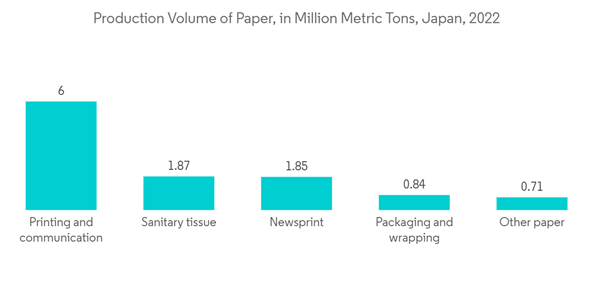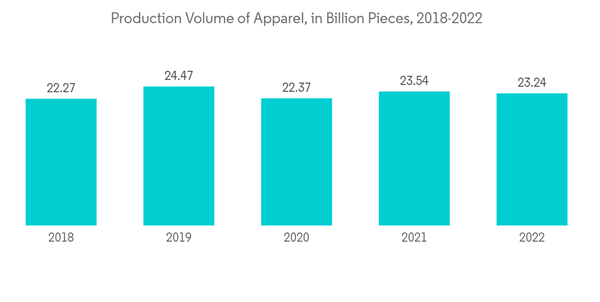The Asia-Pacific hydrogen peroxide market is estimated to reach 2.95 million tons by the end of this year and is projected to reach 3.64 million tons in the next five years, registering a CAGR of 4.27% during the forecast period.
The market was negatively impacted by COVID-19 as it affected economies and industries in various countries of the Asia-Pacific region due to repetitive government-imposed lockdowns, travel restrictions, supply chain breaks, and abrupt business shutdowns. However, with the spread of coronavirus, hydrogen peroxide is extensively being utilized for manufacturing sanitizers and hygiene products. Currently, the market has recovered from the pandemic and is growing at a significant rate.
This product will be delivered within 2 business days.
The market was negatively impacted by COVID-19 as it affected economies and industries in various countries of the Asia-Pacific region due to repetitive government-imposed lockdowns, travel restrictions, supply chain breaks, and abrupt business shutdowns. However, with the spread of coronavirus, hydrogen peroxide is extensively being utilized for manufacturing sanitizers and hygiene products. Currently, the market has recovered from the pandemic and is growing at a significant rate.
Key Highlights
- Over the short term, the increasing use of disinfectant, and in paper and pulp industry are major factors driving the growth of the market studied.
- However, the risk factor for occupational chemical poisoning is likely to restrain the growth of the studied market.
- Nevertheless, technological advancements in the production of hydrogen peroxide are likely to create lucrative growth opportunities for the Asia-Pacific market.
- China represents the largest market over the forecast period due to the presence of a huge mining sector, and a growing retail sector creating demand for paper packaging.
Asia-Pacific Hydrogen Peroxide Market Trends
Paper and Pulp Segment to Dominate the Market
- Hydrogen peroxide is a good bleaching agent for mechanical wood pulp. It makes mechanical wood pulp achieve higher whiteness. It is non-toxic and non-polluting and hardly damages the fiber during bleaching, with less than 1% bleaching.
- The use of this bleaching agent increased significantly in the pulp and paper industry due to ease to use, improved paper quality, lower production costs, increased yield percentage, and being environmentally friendly. The brightness of the paper that is made from hydrogen peroxide bleach is more stable.
- China is the world's largest producer and consumer of pulp and paper products. The country produced over 280 million tons of pulp and paper products combined and consumed over 230 million tons in 2022.
- According to the 2022 Annual Report of China Pulp, compiled by the China Paper Association, the total output of the pulp, paper, and paper products industry reached 283.91 million tons in 2022. This is a slight increase of 1.32 percent from the previous year.
- China's production of paper and cardboard reached 124.25 million tons in 2022, a year-on-year increase of 2.64 percent. However, the production of paper products declined by 4.65 percent year-on-year with a total of 73.79 million tons produced.
- According to a survey from the China Paper Association, there were approximately 2,500 paper and cardboard production companies and 4,727 paper product manufacturers with an annual income of over CNY 20 million (USD 2.77 million) in China in 2022.
- Further, according to Indian Paper Manufacturers Association (IPMA), exports of paper and paperboard from India jumped nearly 80 percent in FY 2021-22, touching a record of INR 13,963 crore (~USD 1,773.30 million). In the last five to seven years, paper mills in India have invested over INR 25,000 crore (~USD 3,175 million) to create new capacities and induction of clean and green technologies.
- Paper Industry in India is exhibiting one of the fastest growths being witnessed anywhere in the world and is most likely to continue this trajectory in the years to come.
- Additionally, according to Japan Paper Association, in 2022, the production volume of paper used for printing and communication in Japan amounted to approximately six million metric tons. The majority of paper produced in Japan was used for printing and communication that year. Newsprint, sanitary tissues, and packaging and wrapping made up much smaller categories.
- Thus, the growing use of paper and pulp is likely to increase the demand for hydrogen peroxide in the forecasted period.
China to Dominate the Market
- China is expected to dominate the hydrogen peroxide market during the forecast period due to the growing paper and pulp, mining industry, and increasing demand from various end-user industries such as food and beverage, textile, and others.
- According to the China Paper Association, China's total pulp production reached 85.87 million tons in 2022, an increase of 5.01 percent over the previous year. The largest sub-segment of the pulp industry was waste paper pulp, of which China produced around 59.14 million tons in 2022. Meanwhile, the production of wood pulp reached 21.15 million tons, an increase of 16.92 percent year-on-year, and non-wood pulp reached 5.58 million tons, up 0.72 percent over the last year. This increased the demand for hydrogen peroxide in the region.
- In the mining industry, hydrogen peroxide is used for the extraction of precious metals such as gold, platinum, and palladium.
- Hydrogen peroxide is often used as an oxidant in metallurgical process steps such as ore leaching, concentrate preparation, or effluent treatment. Depending on the ore composition as well as the leaching conditions, the use of hydrogen peroxide results in savings of effluent treatment reagents and acids simplifies management of chemicals or wastes, and improves the overall process performance.
- In Hong Kong, hydrogen peroxide can be used in food as a bleaching agent provided that the residue should be removed in the finished products. Further, only food grade hydrogen peroxide should be used in processing food and the dosage used should be limited to the amount sufficient for the purpose.
- The company Hangzhou Mingxin Hydrogen Peroxide Co.,Ltd is a professional high-tech enterprise in production of food grade hydrogen peroxide in China which through its food grade hydrogen peroxide enhance the growth of the market.
- Furthermore, China exported textiles, apparel and clothing accessories worth USD 323.344 billion in the entire 2022, registering a slight growth of 2.53 per cent compared to the previous year. Garment and clothing accessories exports reached USD 175.396 billion in 2022, which was 3.2 per cent higher than the same period of last year. China's textile exports, including yarn, fabrics, and others, registered a growth of 2 per cent year-on-year to reach USD 145.079 billion in 2022.
- According to National Bureau of Statistics of China, the world's manufacturing giant China concluded 2022 with USD 175.39 billion revenue in its apparel and accessory exports. As per General Administration of Customs, China (GACC), the country upped its exports by 3.20 per cent on Year-on-Year basis.
- In addition, according to National Bureau of Statistics of China from April 2022 to April 2023, monthly textile production volume was consistently around three billion meters.
- Further, according to China National Garment Association, China produced around 23.24 billion pieces of clothes in 2022.
- Therefore, application of hydrogen peroxide in various industries are likley to increase the demand for hydrogen peroxide through the forecast period.
Asia-Pacific Hydrogen Peroxide Industry Overview
The Asia-Pacific hydrogen peroxide market is consolidated in nature. The major players (not in any particular order) include Arkema, Evonik Industries AG, MITSUBISHI GAS CHEMICAL COMPANY, INC, National Peroxide Limited, and Solvay among others.Additional Benefits:
- The market estimate (ME) sheet in Excel format
- 3 months of analyst support
This product will be delivered within 2 business days.
Table of Contents
1 INTRODUCTION
4 MARKET DYNAMICS
5 MARKET SEGMENTATION (Market Size in Volume)
6 COMPETITIVE LANDSCAPE
7 MARKET OPPORTUNITIES AND FUTURE TRENDS
Methodology

LOADING...










